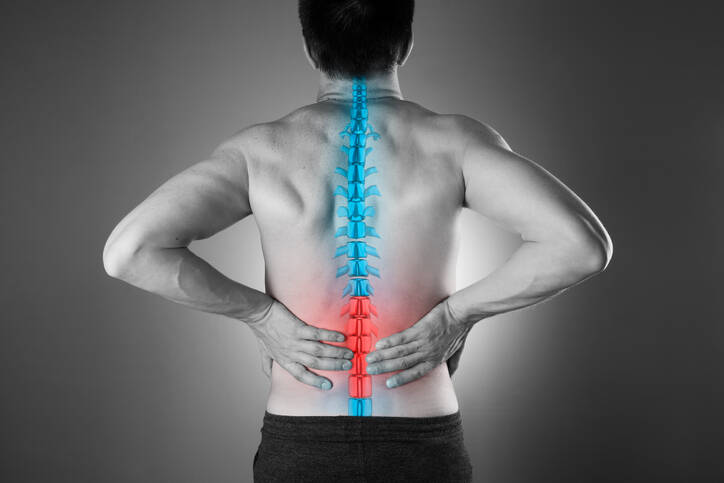Back pain is a current and common problem. It can be acute or last for a long time. The cause is usually a variety of diseases.
One less common disease is infection, otherwise osteomyelitis of the spine or spondylodiscitis.
Osteomyelitis = bone infection. It is caused by various microorganisms. It destroys bone tissue.
Osteo = menas "bone". Myelitis = inflammation of the spinal cord.
Spondylodiscitis consists of...
Spondyl = meaning "vertebra" +
Spondylos from Greek = vertebral +
Disc - from Latin "disci intervertebralis" = intervertebral discs +
Suffix -itis = a Latin ending meaning "infection, infectious disease".
The Spine and the Vertebrae
The spine forms a supportive construction of the human body. It carries the weight of its upper part and plays an important role in movement and defense.
Vertebral column, the spine, the backbone = Lat. "columna vertebralis".
Its specific composition helps achieve the above mentioned functions. The small bones, the vertebrae along with intervertebral discs, the ligaments and the muscles form a special functional unit.
People have 33 or 34 vertebrae. Based on the spinal segment their names are:
- vertebrae Cervicales, cervical vertebrae = 7 vertebrae, labelled from C1 to C7
- vertebrae Thoracicae, thoracic vertebrae = 12 vertebrae, Th1 to Th12
- vertebrae Lumbales, lumbar vertebrae = 5 vertebrae, L1 to L5
- vertebrae Sacrales, sacral vertebrae = 5 alebo 6 vertebrae, S1 - S5 (S6)
- vertebrae Coccygeae, coccyx= 4 or 5 vertebrae, Co1 - Co4 (Co5)
The cervical spine is characterised by a high degree of mobility. It is attached to the skull with the first cervical vertebra.
C1, the first cervical vertebra is called the atlas.
C2 is the second cervical vertebra called the axis. It has an odontoid process (bony protrusion) called the dens and is important for the movements of the head.
The ribs are attached to the thoracic vertebrae. These form the thorax that serves as protection of vital organs.
The lumbar vertebrae are the most resistant. They can bear large loads since they are adapted to this specific function.
The sacral vertebrae are fused into the sacrum - the "os sacrum" in Latin. The sacrum is connected to the lumbar and pelvis joints, which are referred to as SI joints, i.e. sacroiliac joints.
The coccyx, also known as the tailbone, is the final segment of the backbone. It is not just some minor part of it. It is significant.
Learn more about:
SI joint block
Coccydynia or Tailbone pain
It is also important to know that the vertebrae are anatomically adapted so that the spinal cord could pass through them.
The vertebral bodies and arches form the spinal canal.
Spinal cord = medulla spinalis in Latin.
The spinal nerves protrude from the spinal cord.
It is therefore a link between the brain and the rest of the body.
The function of the spinal cord is relaying nerves and coordinating reflexes.
What about intervertebral discs?
The small vertebral joints and the intervertebral discs participate in the body's movement. Thehir Latin name is "disci intervertebralis". That is where the discs get their shortened name from.
They have an important function for the body's movement. They also act as shock absorbers when walking, running, or just moving around. The individual vertebrae do not obstruct each other.
The discd come in different sizes. The largest ones are located in the lumbar region.
There are 23 of them. They stretch from the intervertebral space C2 - C3 to segments L5 and S1.
Between the surface of the vertebral body and the disc is the vertebral endplate. It plays an important role in nutrition and makes sure the vascular and the nervous system get nourished.
Question:
Why are we giving you all this information?
Answer:
A spinal infection primarily affects these parts.
An infection causes damage to the vertebrae, the intervertebral disc and the thin layer between them, i.e. the vertebral endplate.
Coming up:
How spondylodiscitis is defined.
The causes of inflammation.
The symptoms accompanying the disease.
A diagnosis as well as available treatments.
How Spondylodiscitis Is Defined
Spondylodiscitis is an inflammatory disease caused by infection, ie the entry of microorganisms into the spine.
It initially affects the intervertebral disc, the vertebral endplate and the vertebral body.
The disease causes damage to these parts. As a result, this damage causes back pain and other associated neurological disorders, depending on the extent of the affected area.
It is an uncommon disease with a reported incidence of 1: 250,000. This means 2-4% of all bone infections.
It is more common among men.
The age at which it occurs is not precisely delimited.
However, it is more common after the age of 50.
It is often confused with other diseases of the spine. Therefore, effective treatment may be delayed, which presents a risk for potential complications or even death.
The infection affects the segments of the spine to the following approximate extent:
- lumbar (lower back) - 45 to 50 %
- thoracic (torso) - 35 %
- cervical (neck) - 3 to 20 %
- the rest affects the sacral segment











